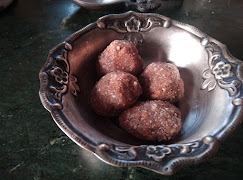Pahari Recipes for Winter
‘Tilotha’
Courtesy: Saroj Mausi
This is a Khichri that is specific to Garhwali families — the source of this recipe is my mother’s elder sister. I am not certain if it is cooked by all Garhwali families, or only those from Dehradun - particularly those with a connection to Tehri and Pauri Garhwal - and incidentally Nepal!
It consists of lobia daal and rice (as opposed to the more common khichri with moong daal and rice) and roasted and ground til, sesame seeds. Hence the name Tilotha. Til is particularly beneficial in winters, as it is supposed to be a warming food. Til appears in various forms in Garhwali food— as chutneys, raitas, ladoos, et al.
Saroj Mausi says that this Khichri is best paired with gall-gall pickle — the big delectable lemons that are pickled with hing, haldi, salt and red chilli powder (the recipe for which will follow soon!)
Tilotha:
Take lobia dal and rice in the proportion of 1:2.
Soak lobia for a couple of hours at least.
Give it a boil with some salt and turmeric.
Now add it to soaked rice.
Add ginger-garlic paste sautéed in mustard oil, and a spoonful of garam masala.
When done, add a big karchi (or a cupful) of roasted ground til seed powder.
Add ghee on top and serve.
Remember the khichri should not have a tight consistency; it should not be watery either.
It should be what mausi calls ‘ladbadi’ - neither watery nor tight, but just right!
'Tilkut' - Another winter special from Saroj Mausi!
Tilkut is an easy and delicious concoction of ginger, jaggery and sesame pounded together. It is made on Sankat Chauth Vrat soon after Lohri/Makar Sankranti. My mother says that this is one week after Sankranti.
I remember Nani was with us in Pratap Chowk in Delhi cantonment one winter, and she made Tilkut in the imam jasta. And told me the story related to it, which I remember only imperfectly. What I do retain of the story is an incident about a lady who did not feed the birds the seeds and jaggery that spilled out during the pounding process, and the bad luck that ensued thereafter.
Nani spread out some newspapers under the imam jasta, and any til or gur that spilled out was then collected and fed to the birds in the garden. The lesson in this that I got was that you should share whatever you have made not just with family and friends, but also with animals and birds. My cousin who now lives in China, says she also remembers the chanting of “Sankat Mata, Sankat kaat" that accompanied the rhythm of the imam jasta pounding.
Here's the recipe in Saroj Mausi's own words.
'1. Take roasted til, say 200 grams or so; 100 grams or "to taste" gur (jaggery) and about 2" piece of ginger cut into small thin pieces.
2. Grind all the ingredients together to the consistency that you can bind the mixture in to small ladoos, or any other shape or size you like so that you can put it straight in your mouth - 3 to 4 after a meal, as a sweet dish in winters!'
I tried out Mausi's recipe, and the results were eminently satisfying!



No comments:
Post a Comment